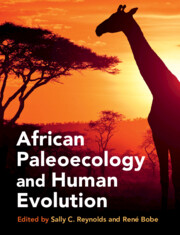Book contents
- African Paleoecology and Human Evolution
- African Paleoecology and Human Evolution
- Copyright page
- Dedication
- Contents
- Contributors
- Acknowledgments
- Part I Modern Africa and Overview of Late Cenozoic Paleoenvironments
- Part II Southern Africa
- Part III Eastern and Central Africa
- Part IV Northern Africa
- 36 The Northern African Sites: Paleoenvironmental Syntheses
- 37 Ahl al Oughlam, Morocco: The Richest Fossil Site in North Africa at the Pliocene/Pleistocene Boundary
- 38 Tighennif (Ternifine), Algeria: Environments of the Earliest Human Fossils of North Africa in the late Early Pleistocene
- 39 Early Homo on the Atlantic Shore: The Thomas I and Oulad Hamida 1 Quarries, Morocco
- Volume References
- Index
- Plate Section (PDF Only)
38 - Tighennif (Ternifine), Algeria: Environments of the Earliest Human Fossils of North Africa in the late Early Pleistocene
from Part IV - Northern Africa
Published online by Cambridge University Press: 19 May 2022
- African Paleoecology and Human Evolution
- African Paleoecology and Human Evolution
- Copyright page
- Dedication
- Contents
- Contributors
- Acknowledgments
- Part I Modern Africa and Overview of Late Cenozoic Paleoenvironments
- Part II Southern Africa
- Part III Eastern and Central Africa
- Part IV Northern Africa
- 36 The Northern African Sites: Paleoenvironmental Syntheses
- 37 Ahl al Oughlam, Morocco: The Richest Fossil Site in North Africa at the Pliocene/Pleistocene Boundary
- 38 Tighennif (Ternifine), Algeria: Environments of the Earliest Human Fossils of North Africa in the late Early Pleistocene
- 39 Early Homo on the Atlantic Shore: The Thomas I and Oulad Hamida 1 Quarries, Morocco
- Volume References
- Index
- Plate Section (PDF Only)
Summary
The site of Tighennif (also known as Ternifine, from the old name Tighenifine, and as Palikao) is located about 20 km east of Mascara in northern Algeria, about 60 km from the Mediterranean sea, at a present-day altitude of around 500 m a.s.l. It was discovered in 1872, soon after the creation by French settlers of the village of Palikao. The sand quarry, west of the village (N 35°24′55″, E 0°19′17″), was worked from 1872 onwards; Pomel (1879) gave the first report on fossil finds and undertook a small excavation in 1882 with Tommasini. Numerous fossils were discovered during the last part of the nineteenth century, and many of them were described in Pomel’s classical monographs, published from 1893 to 1897. However, sand extraction had to be stopped when the excavations reached a famous cemetery. Man-made artifacts were first identified by Tommasini (1886), but doubts were still frequently expressed as to the antiquity of the site, and it is only with the discovery by Pallary in 1928 of a canine of the saber-tooth cat Homotherium that its antiquity was confirmed (Pallary’s material is held at the Institut de Paléontologie Humaine, Paris). Arambourg led new excavations in 1931, but was soon stopped by upwelling of artesian water from the bottom of the deposits; nevertheless, he was the first to reach a clayey level at the base of the deposits. The largest excavations, conducted by Camille Arambourg and Robert Hoffstetter, took place in 1954, 1955, and 1956 on a large scale, employing up to 80 workers. They resulted in the collection of thousands of fossils, numerous artifacts, and several hominin remains that Arambourg (1963a) assigned to Atlanthropus mauritanicus Arambourg, 1954, and that are still the earliest hominin fossils found in North Africa, even though they are now usually assigned to Homo rhodesiensis Woodward, 1921. This material is now deposited at the Muséum National d’Histoire Naturelle, Paris (MNHN). However, upwelling waters necessitated continuous pumping and hindered the study of the stratigraphy and the excavations themselves. Partly for this reason the digging stopped in 1956. Afterwards, thanks to a considerable lowering of the water table that had dried almost all of the fossiliferous levels, small-scale excavations were undertaken by a Franco-Algerian team led by Jean-Jacques Hublin in 1982–1983 (Figure 38.1; Geraads et al., 1986).
- Type
- Chapter
- Information
- African Paleoecology and Human Evolution , pp. 475 - 480Publisher: Cambridge University PressPrint publication year: 2022
- 1
- Cited by



